Africa-Press – Lesotho. Catapulted into the position of secretary general of the ANC, Ramaphosa is at Mandela’s side negotiating freedom for South Africa. In the most dramatic decade in Africa since the independence era – the 1990s – Ramaphosa was at the centre of revolutionary change in South Africa.
He started the era as a socialist trade unionist and ended it as a leader among the country’s new black business elite, with plenty of peaks and troughs in between.
South Africa’s business and political leaders were now talking to the ANC in Lusaka, and to Nelson Mandela in jail in Western Cape. Ramaphosa had become one of the ANC’s most important cadres.
At Mandela’s release on 11 February 1990, Ramaphosa was in the reception committee for the revered leader. Ramaphosa went from being the man who held the microphone for Madiba to heir apparent. It looked a surreal elevation for the 38-year-old union organiser.
Popular with the left and the unions, as well as having the backing of exiled Communist leader Joe Slovo, Ramaphosa was catapulted into the ANC hierarchy at the party’s conference in South Africa in July 1991.
In his autobiography, Mandela gave this accolade: “Ramaphosa was elected secretary general, evidence that the torch was being passed from an older generation to a younger one.
Cyril was a worthy successor to a long line of notable ANC leaders. He was probably the most accomplished negotiator in the ANC. ” The same conference elected Mandela as president and Thabo Mbeki as his deputy. He was probably the most accomplished negotiator in the ANC” – Nelson Mandela
Snuki Zikalala, president of the ANC Veterans’ League, tells The Africa Report that Ramaphosa’s promotion was well-deserved: “Cyril was running the engine room of the ANC, delegates felt he was highly competent, a hard worker and the right man to lead the ANC’s office.
Earlier, Ramaphosa had emerged as leader of the the ANC delegation at the Convention for a Democratic South Africa from 1990 to 1993 to negotiate the country’s transition.
Again, the path hit several obstacles. The worst was the massacre of 46 people at Boipatong in June 1992. The two key negotiators were Ramaphosa and the National Party’s Roelf Meyer.
“What annoyed me was that Cyril and Roelf would go away on fishing trips and come back and then have a position on a particular matter,” argues De Lille.
“This meant that other smaller parties were simply dismissed.
” While Ramaphosa was negotiating the transition and the choice of Mandela’s deputy was being debated, Ramaphosa was losing his power base in the ANC.
Zikalala says: “Cyril was too young to take over from Mandela. He had to learn how the ANC works. Thabo was a senior leader, more experienced and had a vision for the country.
” After winning the ANC elections, Mandela asked Ramaphosa to chair the drafting committee for the new constitution.
After two years of hard-fought negotiations with apartheid-era politicians and Mangosuthu Buthelezi’s nationalist Inkatha Freedom Party, Ramaphosa’s team produced a world-class liberal constitution that was adopted at a grand ceremony on 8 May 1996. Stung by the pause in his rise to power, just four days later Ramaphosa resigned from parliament and as ANC secretary general.
For More News And Analysis About Lesotho Follow Africa-Press






